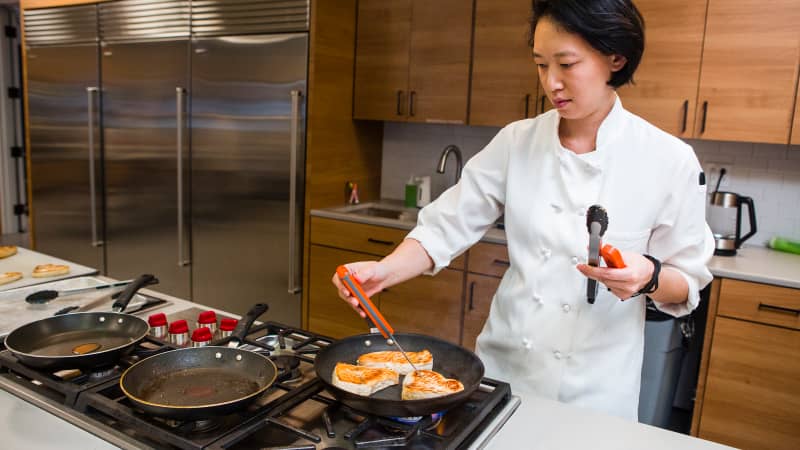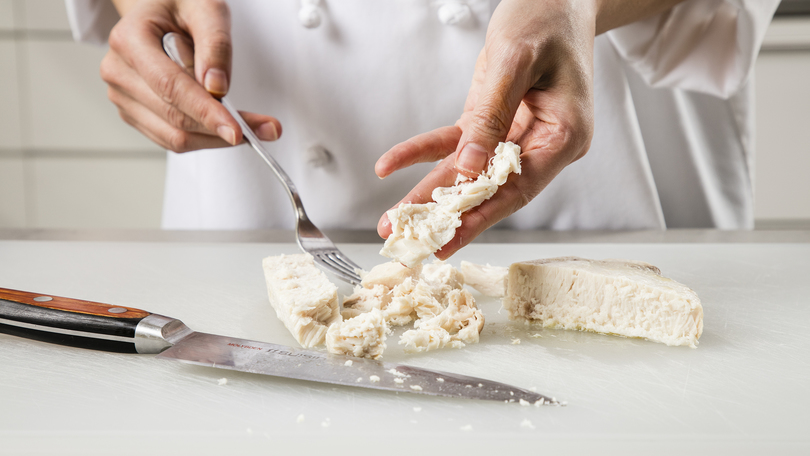My Goals
- Quick and easy method
- Dense, meaty texture
- Juicy interior
Published Aug. 1, 2018.

I’ve long wondered why the texture of swordfish can sometimes be perfect—meaty, juicy, and tender—and other times so unpleasant.
It seems funny to admit that a fish was once my nemesis, but there was a spell back when I was a line cook when that was exactly the case. For five straight nights, I carefully prepared what appeared to be pristine swordfish steaks and began to plate them up, only to find that they were soft and mushy. The restaurant waitstaff then had to inform the diner that his or her entrée choice had been taken off the menu for the evening. Back then, I didn’t know what to attribute the poor—not to mention wasteful—results to, and we ultimately stopped serving swordfish altogether. But I’ve long wondered why the texture of swordfish can sometimes be perfect—meaty, juicy, and tender—and other times so unpleasant. It was time to use a scientific approach to figure out why—and come up with a solution.
It would be a worthwhile effort: I knew that swordfish, unlike silky salmon or flaky halibut, at least had the potential to offer a unique dense meatiness. This distinctive texture, combined with a sweet, mild flavor, could excite even a staunch carnivore. In fact, swordfish steaks are similar enough to beef steaks that I decided to start my investigation by looking to one of the test kitchen’s favorite methods for cooking steak.
We call it reverse searing: First, we gently cook the meat in the oven until it’s perfectly juicy and tender, and then we transfer it to the stovetop to quickly brown the exterior. I seasoned four 8-ounce swordfish steaks with salt and cooked them gently in a 300-degree oven for about 45 minutes, until they were a few degrees shy of 140 degrees, a temperature that the test kitchen likes for white fish. Next, I briefly seared the fish steaks in an oil-slicked nonstick skillet until they acquired a golden-brown crust and let them rest for a few minutes. They looked gorgeous, but I knew all too well that a good-looking swordfish exterior often hides a disappointing interior. Sure enough, although some tasters charitably described the fish as “too tender,” most reported that it had the soft, tacky, almost mushy texture of canned tuna.

After consulting with our science editor, I understood what was going on. Just like meats, fish contains enzymes called cathepsins. If the circumstances are right, the cathepsins will snip the proteins that give swordfish its sturdy texture, turning it soft. Although they’re ultimately destroyed by heat, cathepsins are increasingly active at low cooking temperatures. By slowly bringing the swordfish steaks up to 140 degrees, I was giving the cathepsins plenty of time to take the flesh from meaty to mushy.
Just as with land-bound critters, enzymes can have a profound impact on the texture of swordfish. To explore this, we cooked 12 swordfish steaks to 130 degrees—the temperature at which they need to be taken off the heat to carry over to a 140-degree serving temperature. We then held batches of four steaks at 130 degrees for 15 minutes, 45 minutes, and 1 hour and 45 minutes. Next, we measured the amount of force required to compress each sample ½ inch to quantify the experience of taking a bite. We found that the longer the fish stayed at 130 degrees, the softer it became. In fact, the force required to compress the fish at 15 minutes had decreased by about 15 percent after 45 minutes and 30 percent after 1 hour and 45 minutes.
Here’s the explanation: Enzymes in swordfish called cathepsins snip the proteins that hold the muscle fibers together. In fish, cathepsins are highly active at 130 degrees. When swordfish is cooked very slowly, its cathepsins have a long time to turn its flesh soft and mushy.
Clearly, I needed to speed up the cooking. The fastest way to cook these (or any) steaks indoors would be to sear them in a skillet. The metal in the pan would conduct heat to the fish more rapidly than even the hottest oven or broiler. In a skillet, flipped once halfway through cooking, the steaks were done in just 16 to 18 minutes. Tasters agreed that this was a step in the right direction: Each bite was firmer since the enzymes hadn’t been given much time to act. But I wasn’t going to get off that easy. The swordfish was dry and tough just beneath the well-browned crust.
It made sense that the portions of the swordfish that had been nearest to the hot skillet were overcooked. The part of the fish that’s in contact with the pan heats up very quickly because of the skillet’s ability to transfer heat. That portion of the flesh must in turn transfer that heat to the layers adjacent to it. And most food, swordfish included, doesn’t transfer heat quickly. The upshot is that as the interior slowly heats up, the exterior overcooks. But if gentle cooking turned these steaks to mush and a hard sear—necessary for preserving their texture—left them wrung out, where did that leave me?

I had flipped the steaks only once during cooking. What if I flipped them more frequently? After the first flip, the steaks would cook from both sides. Simultaneously, the top side would get a reprieve from the hot pan, which could minimize overcooking.
We have noticed that frequently flipping swordfish (as well as beef steaks, pork chops, and tuna) during searing leads to faster, more evenly cooked results. To demonstrate this, we pan-seared nine swordfish steaks, nine strip steaks, and nine pork chops until they reached 130, 125, and 140 degrees, respectively. We flipped three of each protein every 30 seconds, three every 2 minutes, and three just once, recording how long it took each to reach the desired temperature.
The proteins flipped every 30 seconds cooked the fastest, while those flipped just once were the slowest. The 30-second and 2-minute samples were well browned and evenly cooked, whereas the once-flipped samples were also nicely browned but had a large band of overcooked flesh.
Here’s why frequent flipping is efficient: A hot skillet cooks food from the bottom up. When a protein is flipped, the seared side, which is then facing up, is also quite hot. Some of its heat dissipates into the air, and some of it cooks the protein from the top down. The more often a protein is flipped, the more it will cook from both the bottom up and the top down.
Though flipping pan-seared proteins every 30 seconds results in the speediest, most even cooking, it is impractical. However, flipping every 2 minutes cuts the cooking time by about 30 percent, which makes it well worth the effort.
When my oiled skillet began to smoke, I added the swordfish steaks. I flipped them every 2 minutes, and after about 10 minutes, they hit 140 degrees. This significantly cut the cooking time, and the steaks were much improved. They were cooked throughout and sported golden-brown crusts, and each bite was dense and meaty. There was just one problem: The fish oozed juices as it rested. A quick temperature check revealed the reason. The aggressive cooking had caused the fish to carry over to 150 degrees. And at such a high temperature, the proteins shrank and squeezed out juices. I seared another batch, this time pulling the steaks from the skillet when they registered just 130 degrees. That did the trick: During a 10-minute rest, they climbed to the target temperature of 140 degrees.
Though the rich, meaty, juicy steaks were great with just a squeeze of lemon, I wanted to celebrate the conquering of my nemesis (how I wish I knew then what I know now!) with a couple of sauces. One was a classic Italian swordfish accompaniment, an agrodolce-style relish based on piquant capers and sweet currants; the other was an ultragarlicky sauce with the unique addition of dried mint.
Quick and easy method
We stick with pan-searing the swordfish to cook it quickly and evenly.
Dense, meaty texture
Slow cooking damages swordfish’s meaty texture. By flipping the steaks every 2 minutes to speed up cooking, we prevent the steaks from acquiring a tacky texture.
Juicy interior
By removing the steaks from the skillet when they register 130 degrees, we prevent them from overcooking as they rest.

This is a members' feature.